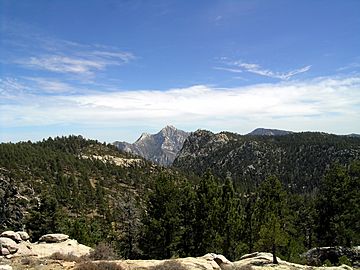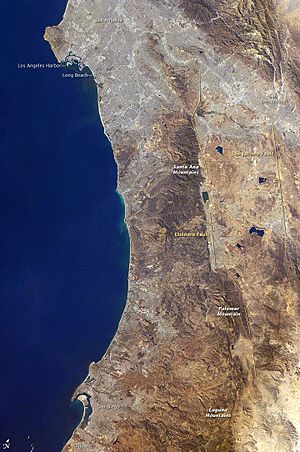Peninsular Ranges facts for kids
Quick facts for kids Peninsular Ranges |
|
|---|---|

Sierra San Pedro Mártir and Devils Peak, Southern Baja California, Mexico
|
|
| Highest point | |
| Peak | San Jacinto Peak |
| Elevation | 10,834 ft (3,302 m) |
| Geography | |
| Countries | Mexico and United States |
| Geology | |
| Age of rock | Mesozoic |
| Type of rock | Granite |
The Peninsular Ranges are a long chain of mountains. They stretch for about 1,500 kilometers (930 miles) from Southern California in the United States all the way to the southern tip of the Baja California Peninsula in Mexico. These mountains are part of a bigger group called the Pacific Coast Ranges, which run along the Pacific Ocean from Alaska down to Mexico. The mountains in the Peninsular Ranges can be as low as 500 feet and as high as 10,834 feet!
Contents
Geography of the Peninsular Ranges
The Peninsular Ranges include many mountains. In Southern California, you'll find the Santa Ana Mountains, San Jacinto Mountains, and Laguna Mountains. As you go south into Baja California, Mexico, you'll see ranges like the Sierra de Juárez, Sierra de San Pedro Mártir, and Sierra de la Giganta.
Palomar Mountain, famous for its Palomar Observatory, is also in these ranges in San Diego County. Most of the Peninsular Ranges run from north to south. This is different from the Transverse Ranges to their north, which mostly run from east to west.
Geology: How the Mountains Formed
The rocks in the Peninsular Ranges are mostly made of granite. These rocks formed a very long time ago, during the Mesozoic Era (the time of dinosaurs!). They come from a huge mass of molten rock called a batholith. This is the same type of rock that makes up the core of the Sierra Nevada Mountains in California.
These mountains are part of a special geological area called the Salinian Block. This block of land broke away from the main North American Plate. This happened as the San Andreas Fault and the Gulf of California began to form.
Ecology and Flora: Plants of the Ranges
Northern Plants (Nearctic Realm)

Most of the Peninsular Ranges are in the Nearctic realm. This means they have plants and animals similar to those found in North America. Different types of natural areas, called ecoregions, cover parts of these mountains.
On the western side of the northern ranges, you'll find California montane chaparral and woodlands. This area has tough, shrubby plants that can handle dry summers. On the western side of the southern ranges, the Baja California Desert ecoregion takes over. This area is much drier.
On the eastern side of the northern ranges, the Sonoran Desert ecoregion is present. This desert stretches into southeastern California and northeastern Baja California. Anza-Borrego Desert State Park in San Diego County is famous for its beautiful desert wildflowers in spring. Further south on the eastern side, near the Gulf of California, the Gulf of California xeric scrub ecoregion is found.
The higher parts of the Peninsular Ranges have forests. These forests are especially thick on the slopes that face west. Cleveland National Forest covers many of the higher parts of the Southern California Peninsular Ranges. Here, you can find oak woodlands and forests of Jeffrey pine and Coulter pine.
In Baja California, the Sierra Juarez and San Pedro Martir pine-oak forests grow on the upper slopes. These isolated forests have trees like Tamarack Pine, Sugar Pine, Parry pinyon, White fir, and California Incense Cedar. You can also find different types of oak trees here, such as Coast Live Oak and Engelmann Oak. Many rare and unique plant species, called endemic species, live only in these higher parts of the Peninsular Ranges.
Southern Plants (Neotropical Realm)
The very southern end of the Baja California Peninsula is part of the Neotropical realm. This means it has plants and animals similar to those found in Central and South America. The Sierra de la Laguna mountain range is in this area.
Long ago, this southern tip of the peninsula was connected to mainland Mexico. It then broke off and became an island for a while. Because of this, its plants and animals developed differently from the northern parts of the peninsula. This area has three special ecoregions: the Sierra de la Laguna dry forests, Sierra de la Laguna pine-oak forests, and San Lucan xeric scrub.


